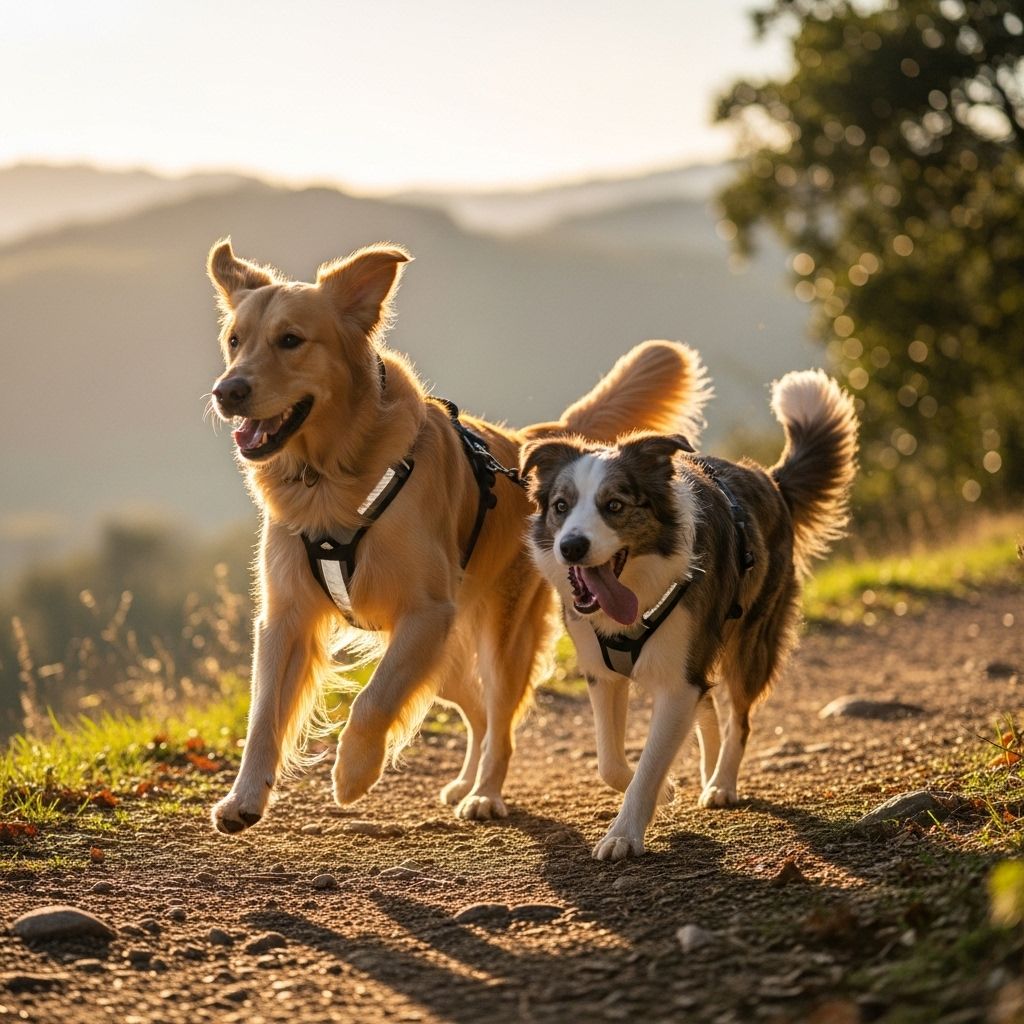Best Dog Breeds for Running Companions: 10 Top Picks
A loyal canine sidekick can turn every workout into a rewarding adventure.

Best Dog Breeds for Running Companions
Having a loyal dog join you on your daily run doesn’t just provide motivation—it can make every mile more enjoyable and rewarding. But not every breed is built for distance, speed, or the great outdoors. This guide highlights the top dog breeds for runners, their unique strengths, and practical tips for choosing the ideal running partner for your fitness journey.
Why Run with a Dog?
Besides the joy of canine company, running with a dog can:
- Boost your commitment by establishing a shared routine.
- Enhance safety during solo jogs, especially with protective breeds.
- Provide mental stimulation and health benefits for both owner and dog.
- Build a deeper bond through regular, active time outdoors.
What Makes a Great Running Dog?
Not all dogs are natural runners. Breeds best suited to running often share several key characteristics:
- High energy levels
- Strong stamina and endurance
- Good trainability—able to learn commands and adapt to pacing
- Athletic build—suited for the type and distance of running you prefer
- Sound health and lack of physical limitations (e.g., hip problems, overheating risk)
Keep in mind that age, prior training, and individual temperament also play major roles in suitability and enjoyment.
Top Running Dog Breeds
Several breeds stand out as excellent companions for runners, thanks to their endurance, athleticism, and enthusiasm for activity. Here are the most notable breeds for runners, with guidance on how they might fit your running style.
Weimaraner
The Weimaraner, a sleek and athletic medium-to-large breed, thrives on vigorous, lengthy exercise. Originally bred for hunting, they are highly energetic, intelligent, and possess tremendous stamina—making them ideal for longer, steady-paced runs. Their affectionate, social temperament also means they’ll look forward to every outing with you.
- Best for: Long-distance runs, trail runs
- Energy level: Exceptionally high
- Notable trait: Needs both physical and mental stimulation
Dalmatian
Known for their striking spots and impressive endurance, Dalmatians were originally coach dogs, running beside horse-drawn carriages for miles. As such, they are strong, athletic, and could keep pace with fast runners over long stretches. They tend to have a high-impact stride, so soft trails are generally better than pavement for their joints during distance runs.
- Best for: Long, steady runs on softer surfaces
- Energy level: Very high
- Notable trait: Legendary stamina
Vizsla
The Vizsla is a medium-sized, Hungarian hunting dog with a distinctive short red coat. Their robust build and eager demeanor make them natural running partners. With their agility and boundless energy, Vizslas are equally comfortable in heat (thanks to their thin coat) and are often cited as one of the best jogging companions around.
- Best for: Runs in warm climates, daily vigorous exercise
- Energy level: Extremely high
- Notable trait: Likes close companionship on runs
German Shorthaired Pointer
Combining speed, endurance, and intelligence, the German Shorthaired Pointer is bred for action. Their muscular, athletic form and versatility mean they excel at both distance and pace work. Pointers are happiest when outdoors with their owner, often thriving on high-mileage sessions that challenge both their bodies and minds.
- Best for: High-mileage runs, varied terrain
- Energy level: Very high
- Notable trait: Loves exploring new environments
Rhodesian Ridgeback
Originally bred in Africa to hunt lions, the Rhodesian Ridgeback is fast, powerful, and blessed with formidable endurance. Their natural gait and strong drive make them adept at longer distances. Ridgebacks are also loyal and protective, adding a comforting sense of security during your jogs.
- Best for: Longer-distance, steady runs
- Energy level: High
- Notable trait: Calm, determined demeanor
Labrador Retriever
Labrador Retrievers are consistently ranked among the best breeds for running, thanks to their drive, sociability, and work ethic. Labs are highly adaptable—they can joyfully join you for both brisk, short runs and longer, slower distances. Their easy-going nature and eagerness to please make them beginner-friendly choices for almost any runner.
- Best for: Short to long runs, family runners
- Energy level: High
- Notable trait: Exceptionally friendly and trainable
Golden Retriever
The Golden Retriever shares many of the same strengths as the Labrador, with equal enthusiasm for exercise and loyal companionship. Their strong build and balanced temperament equip them well for both brisk jogs and more relaxed, extended outings. Goldens, much like Labs, are great for families who want an all-around active companion.
- Best for: Moderate-pace, longer runs
- Energy level: High
- Notable trait: Sociable and gentle with children
Pit Bull (Including Staffordshire Bull Terrier & American Staffordshire Terrier)
Pit Bulls—a term that covers American Staffordshire Terriers and Staffordshire Bull Terriers—have remarkable strength and determination. Though lower to the ground, they are muscular and enjoy brisk, shorter runs. With good training, they can become dedicated, focused running partners who match your pace with enthusiasm and power.
- Best for: Short, energetic runs
- Energy level: Medium to high
- Notable trait: Highly loyal and responsive to training
English Setter
The English Setter is an athletic, symmetrical dog historically bred for upland game hunting. Known for their stamina and gentle personality, English Setters enjoy brisk, shorter excursions or interval runs. They are active, require plenty of exercise, and tend to enjoy playful time after their jog as well.
- Best for: Short, brisk runs; interval sessions
- Energy level: High
- Notable trait: Active and playful, with noticeable endurance
Beagle
Despite their small-to-medium stature, Beagles are quick, energetic, and possess a real enthusiasm for physical activity. While not suited to long, slow distances, they excel in chasing sprints and brisk short runs. Their curious nose may occasionally lead them astray, but with training, they can be wonderful running buddies.
- Best for: Short, frequent bursts and sprints
- Energy level: High
- Notable trait: Very active, good for runners seeking quick, lively outings
Honorable Mentions: More Great Running Dogs
- English Springer Spaniel – Agile and lively, ideal for interval and moderate-length runs.
- Border Collie – Exceptionally smart and energetic, thrives on challenging, varied routes.
- Parson Russell Terrier – Small but mighty, these terriers can keep up physically and mentally on adventures.
- Doberman Pinscher – Sleek, muscular, and confident, great for advanced runners who seek endurance and speed.
- Irish Setter – Happy, enthusiastic, and graceful, these setters enjoy leafy trails and long runs alike.
How to Choose the Right Dog for Your Running Style
Finding the perfect running dog depends on more than a breed’s historical profile. Consider the following:
- Your typical running distance and environment—Trail, urban, or mixed? Distance or intervals?
- Your pace and frequency—Fast sprints or steady jogs? Daily or occasional?
- Dog’s age and physical health—Puppies and seniors may not be able to handle sustained activity.
- Climate—Short-haired breeds can tolerate heat better; double-coated breeds may excel in cooler climates.
Always match your dog’s fitness level and temperament to your lifestyle for a rewarding, lifelong partnership.
Training Tips for Running with Your Dog
- Start slow: Build up distance and intensity gradually so your dog can adapt and avoid injury.
- Use a proper leash: A hands-free or waist-attached leash can enhance safety and comfort.
- Monitor for signs of fatigue: Panting, limping, or slowing down means it’s time to stop and rest.
- Keep water handy: Hydration is vital for both human and canine runners, especially in warm weather.
- Mind the paws: Pavement and hot surfaces can cause burns or abrasions; consider dog booties or stick to soft trails as needed.
- Practice obedience: Basic training (sit, stay, heel) ensures safety for both of you on busy routes.
Breed Comparison Table
| Breed | Best For | Energy Level | Special Notes |
|---|---|---|---|
| Weimaraner | Long, steady runs | Very High | Needs ample physical & mental activity |
| Dalmatian | Long runs (soft trails preferred) | Very High | Legendary stamina, better on non-pavement |
| Vizsla | Warm weather runs | Extremely High | Enjoys strong companionship |
| German Shorthaired Pointer | High mileage, all-terrain | Very High | Loves exploring and variety |
| Rhodesian Ridgeback | Long distance, steady | High | Loyal, protective, calm |
| Labrador Retriever | Short/long runs, family | High | Very trainable & adaptable |
| Golden Retriever | Moderate-long runs | High | Social and gentle |
| Pit Bull (Staffordshire terriers) | Brisk, short runs | Medium-High | Responsive to good training |
| English Setter | Short, brisk runs | High | Gentle, needs regular activity |
| Beagle | Sprints, short runs | High | Lively, can be single-minded |
Frequently Asked Questions (FAQs)
Q: Can any dog breed be a running partner?
A: Not all breeds are suited for running. Brachycephalic (flat-faced) breeds, toy breeds, and breeds with joint or respiratory issues should avoid distance runs. Always consult your veterinarian before starting a running routine with a new dog.
Q: At what age can a dog start running regularly?
A: Puppies and young dogs should avoid structured running until their joints are fully developed—usually between 12–18 months for most breeds. Early overexertion can lead to future orthopedic problems.
Q: How far can these breeds typically run?
A: Distance varies by breed, individual fitness, and training. Endurance breeds like the Weimaraner, German Shorthaired Pointer, and Vizsla can often build up to 10+ miles, provided health is monitored closely. Smaller breeds or those built for sprints (like Beagles or Pit Bulls) do best with shorter, more frequent runs.
Q: What health precautions should I take when running with my dog?
A: Monitor your dog for overheating, dehydration, and paw wear. Avoid running in extreme heat or cold, and provide fresh water before, during, and after runs. Schedule regular veterinary checks to ensure your running companion remains healthy and happy.
Q: Are there breeds that shouldn’t be run with at all?
A: Yes. Breeds with short noses (Pugs, Bulldogs), giant breeds (Great Danes), and those prone to joint or respiratory issues generally should not participate in sustained running.
Conclusion: Sharing the Road—And the Joy—With a Canine Companion
Choosing the right running dog is as personal as your running shoes. Focus on breeds known for their endurance, sociability, and fit for your active life. With patience and the right training, the perfect canine partner can transform your runs into the most anticipated part of every day—promoting health, happiness, and a lasting bond between human and dog.
References
- https://www.akc.org/expert-advice/health/best-running-dogs/
- https://athletechnews.com/the-best-dog-breeds-to-run-with-according-to-new-research/
- https://www.runnersworld.com/runners-stories/a64376435/best-dogs-for-runners/
- https://www.cairntalk.net/blogs/entry/1973-best-dog-breeds-for-running-companions/
- https://www.akc.org/expert-advice/dog-breeds/8-dog-breeds-perfect-for-athletes/
Read full bio of Srija Burman












